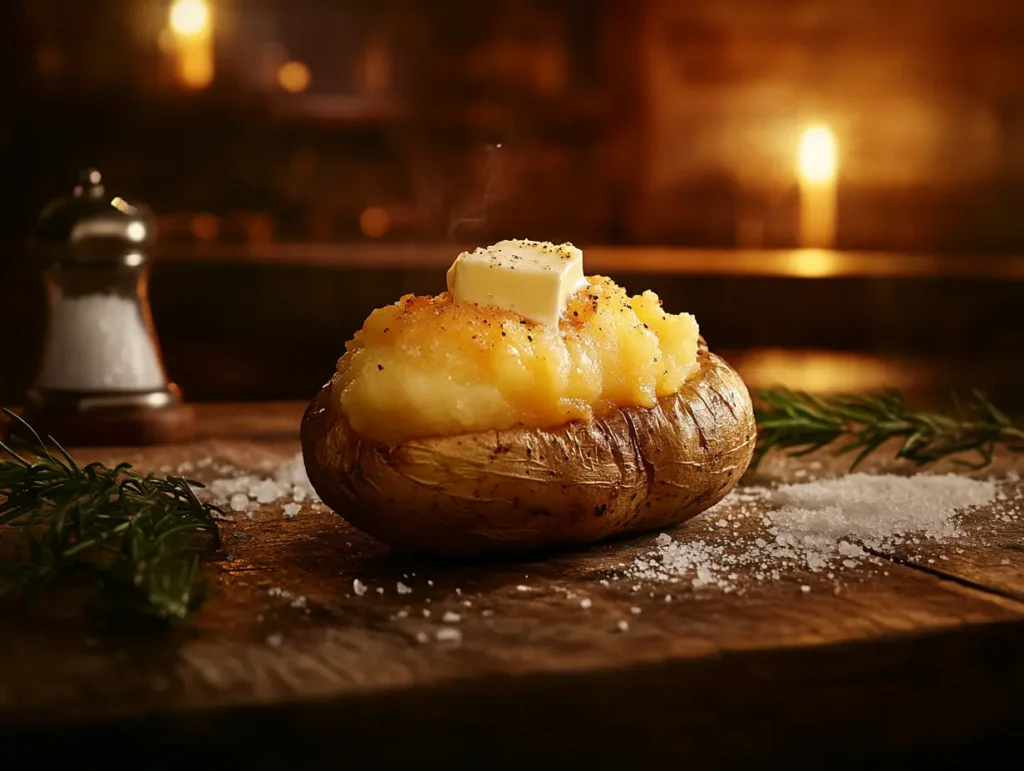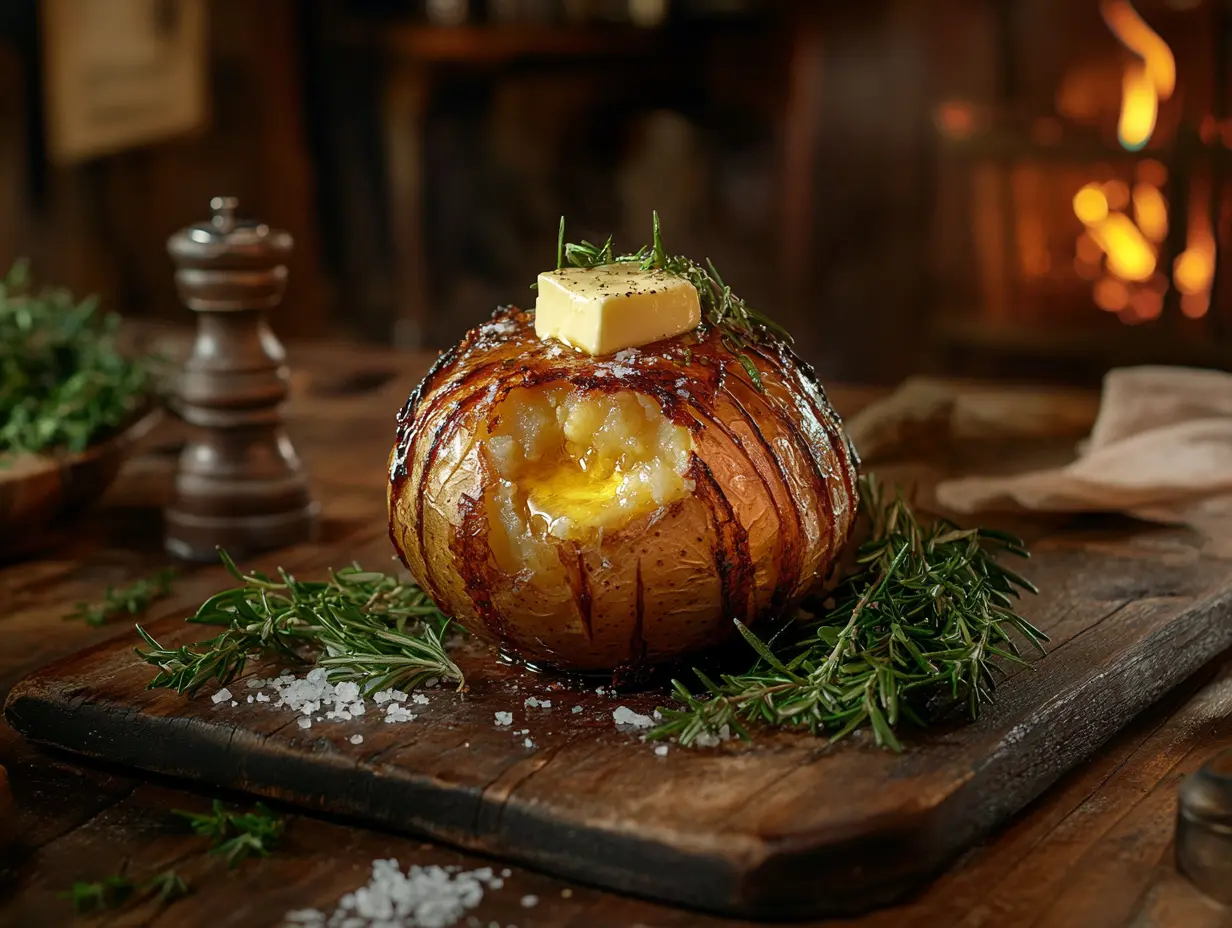Table of Contents
Why salt baked potatoes? This common culinary practice is more than just tradition—it’s a simple yet powerful technique that transforms baked potatoes into a flavorful and texturally perfect side dish. From enhancing the skin’s crispiness to boosting the potato’s natural flavor, salting is the secret behind the irresistible baked potatoes served in restaurants. In this guide, we’ll uncover the science, benefits, and methods to recreate this technique at home.
The Culinary Purpose of Salting Baked Potatoes
What Does Salt Do to the Potato Skin?
When it comes to baked potatoes, the skin isn’t just a wrapper—it’s an essential part of the dish. By adding a layer of salt to the skin, restaurants create a crispy exterior that’s bursting with flavor. The coarse granules of kosher or rock salt work their magic by drawing out moisture from the potato skin as it bakes, leaving it delightfully crunchy. This process also allows the salt to penetrate slightly into the flesh, subtly enhancing the potato’s natural taste.
Salt also ensures that the skin doesn’t become rubbery or overly soft during cooking. Without this step, the skin might turn soggy, losing the textural contrast that makes a baked potato so satisfying.
How Salt Affects Moisture Retention
Ever noticed how restaurant potatoes seem perfectly cooked every time? That’s no coincidence. Salting the exterior helps regulate moisture levels during baking. Salt acts like a culinary insulator, sealing the skin to prevent excess steam from escaping. This keeps the inside of the potato fluffy and moist while ensuring the skin stays crisp.
The combination of salt and heat forms a delicate balance. As the potato bakes, the salt crust creates a barrier, locking in the natural moisture and flavor of the potato. This method not only improves texture but also enhances the overall eating experience. Who doesn’t love breaking through a crackly, salty skin to reveal soft, buttery potato flesh?

By understanding these culinary benefits, it’s easy to see why restaurants rely on this technique to elevate a simple baked potato into a show-stopping side dish. Stay tuned for Part 2, where we’ll dive deeper into the science behind salting and how it transforms the humble spud into a masterpiece.
The Science Behind Salting
Chemical Reaction During Baking
The practice of salting baked potatoes isn’t just a culinary trend—it’s backed by science. When you coat a potato with salt before baking, the salt acts as an insulator, evenly distributing heat across the surface. This uniform heating prevents overcooking and ensures that the starch molecules inside the potato gelatinize perfectly, resulting in a soft, fluffy texture.
Salt also interacts with the potato’s natural sugars, enhancing caramelization. This reaction contributes to the deliciously browned skin you often see on restaurant-style baked potatoes. So, the next time you savor that crispy crust, thank the humble chemistry of salt and heat.
Flavor Enhancement Properties of Salt
Salt isn’t just a seasoning; it’s a flavor amplifier. By salting the exterior of a baked potato, restaurants ensure that every bite packs a punch. The coarse salt crystals dissolve as the potato bakes, allowing them to infuse into the flesh subtly. This process elevates the natural earthy flavors of the potato.
Moreover, salt enhances textural contrast. The crispiness of the skin paired with the creamy interior creates a dining experience that’s both satisfying and dynamic. It’s no wonder that salted baked potatoes remain a restaurant favorite!
Traditional and Modern Restaurant Practices
Historical Context of Salt Usage in Cooking
Salt has been a kitchen staple for centuries. Historically, cooks used salt crusts to bake various foods, including fish and poultry, as a way to seal in moisture and enhance flavor. This technique eventually extended to potatoes, which benefited greatly from the same principles.
In traditional recipes, chefs buried potatoes in salt or layered them with a crust made from coarse salt and egg whites. These methods provided not only flavor but also a unique presentation that delighted diners. Today’s salted baked potatoes, while simpler, draw inspiration from these age-old culinary practices.
How Restaurants Prepare Salt-Baked Potatoes
Modern restaurant kitchens have streamlined the salting process without compromising on results. Typically, chefs start by scrubbing the potatoes and patting them dry. A light coat of oil is applied to help the salt adhere and enhance browning. Then, the potatoes are rolled in kosher salt or rock salt to form an even coating before being baked at high temperatures.
Some establishments experiment with additional flavors by mixing herbs or spices into the salt coating. This innovation allows for unique variations that cater to different palates. For example, rosemary-infused salt can add a rustic touch, while smoked salt imparts a bold, rich flavor.
Restaurants often emphasize the importance of serving salted baked potatoes immediately after baking to maintain the perfect balance of crispness and fluffiness. This attention to detail is what makes them a hit with customers.
For tips on pairing these delicious baked potatoes with complementary dishes, explore resources like CozzyRecipes, where you can find creative meal ideas to elevate your dining experience.
Benefits for Restaurant Operations
Enhancing Customer Experience
Why do restaurants put salt on the outside of baked potatoes? The answer isn’t just about taste; it’s also about presentation and customer satisfaction. Salted potato skins look visually appealing, catching the eye with their textured, slightly glistening surface. This aesthetic touch adds to the overall dining experience, as many customers eat with their eyes first.
The contrast between the crispy, salted skin and the soft, fluffy interior creates a memorable texture that diners love. This duality elevates a simple baked potato to a premium side dish, leaving customers impressed and eager to return. Moreover, seasoned skins encourage more people to eat the entire potato, reducing waste and maximizing value.
Cost and Efficiency Factors
From a practical standpoint, salting the outside of potatoes is both affordable and efficient for restaurants. Kosher and rock salts are inexpensive and easy to apply, making them perfect for high-volume settings. The salt layer also helps maintain the potatoes’ quality, even if they need to be kept warm before serving.
Salt acts as a protective barrier, ensuring that the skin remains crisp even after baking. This consistency helps restaurants serve dishes that meet customer expectations every time. By combining low cost with high impact, this method strikes a perfect balance for both taste and efficiency.
For other creative ideas to elevate simple ingredients, check out our guide on delicious side dishes and recipe ideas.
How to Recreate Restaurant-Style Salt-Baked Potatoes at Home
Essential Ingredients and Tools
Want to enjoy restaurant-style baked potatoes in your own kitchen? Start with the right ingredients. Opt for large, starchy potatoes like Russets, as their fluffy interior contrasts beautifully with a crispy skin. For the salt layer, choose kosher salt or coarse sea salt—these types adhere better and provide even seasoning.
To get that perfect crust, you’ll also need a light coating of neutral oil, such as canola or olive oil, to help the salt stick. Gather basic tools like a baking sheet, aluminum foil, and a fork for prepping the potatoes.

Step-by-Step Guide
- Prepare the Potatoes: Wash the potatoes thoroughly, scrubbing off any dirt. Dry them completely to ensure the skin crisps up properly.
- Apply Oil and Salt: Rub each potato with a thin layer of oil. Roll them in a shallow dish filled with kosher salt, making sure to coat all sides evenly.
- Bake to Perfection: Preheat your oven to 400°F (200°C). Place the potatoes directly on the oven rack or on a foil-lined baking sheet. Bake for 50–60 minutes, or until the skins are crisp and the interior is fork-tender.
- Serve Immediately: Slice open the potato and top it with butter, sour cream, or your favorite seasonings for a restaurant-quality dish.
Experiment with your toppings or pair these potatoes with hearty mains. For more inspiration, check out our creative recipe collections. You’ll find plenty of ideas to elevate your meals!
Stay tuned for the final section, where we answer common questions about this beloved restaurant practice.
Common Questions About Salting Potatoes
Does the Type of Salt Matter?
Absolutely! The type of salt you use can make a big difference in the outcome. Coarse salts like kosher salt or sea salt are ideal for salting baked potatoes because they stick well to the skin and provide even coverage. Finely ground table salt, on the other hand, may dissolve too quickly and fail to create the desired crust.
For home cooks aiming to replicate the restaurant experience, using kosher salt is a no-brainer. Its larger crystals not only enhance texture but also improve the visual appeal of the potato.
Can You Use Salt Alternatives?
If you’re looking for alternatives to traditional salt, don’t worry—you have options. Seasoned salts or blends infused with herbs can add a new layer of flavor to the skin. However, keep in mind that these alternatives might not deliver the same crispiness as pure salt. For those on low-sodium diets, unsalted seasonings like garlic powder or paprika can also be used to enhance the potato’s flavor.
How Do You Keep the Salt from Falling Off?
One common question is how to make the salt stick. The answer lies in the oil. A light coating of neutral oil like canola or olive oil acts as an adhesive, ensuring the salt stays in place during baking. By combining oil with coarse salt, you’ll achieve the perfect crust every time.
FAQs
- Why do some restaurants use rock salt instead of kosher salt?
Rock salt is larger and provides a thicker, crunchier crust, which some chefs prefer for presentation and texture. - Is salting the outside of baked potatoes necessary?
While not mandatory, salting enhances both flavor and texture, making it a popular choice for restaurants aiming to serve premium-quality potatoes. - Can you eat the salted skin safely?
Yes! As long as the potatoes are cleaned well before baking, the salted skin is completely safe—and delicious—to eat. - What’s a good way to make low-sodium baked potatoes?
Swap out salt for other seasonings like herbs, spices, or even nutritional yeast for a flavorful, sodium-free alternative.
Popular Variations of Salted Baked Potatoes
Regional Takes on Salted Potatoes
Across the globe, chefs have added their unique twists to the classic salted baked potato. In some Mediterranean regions, coarse sea salt is infused with herbs like rosemary or thyme before being applied to the potatoes. This variation not only enhances flavor but also adds a rustic, aromatic quality to the dish.
In the southwestern United States, chili powder or smoked paprika is often mixed with the salt coating, giving the potatoes a bold, spicy kick. This approach is perfect for pairing with barbecue or other hearty meals, adding an extra layer of complexity.
Flavor-Infused Salt Blends
Many restaurants are experimenting with flavored salts to elevate their baked potatoes. Truffle salt, for instance, adds a luxurious, earthy taste that complements the potato’s natural flavors. Lemon salt, on the other hand, introduces a zesty brightness, making the dish feel lighter and more refreshing.
If you’re looking to recreate these variations at home, try experimenting with different seasonings to suit your palate. The possibilities are endless, proving that the question why do restaurants put salt on the outside of baked potatoes often comes down to creativity and innovation.

Final Thoughts on Salted Baked Potatoes
Salted baked potatoes are more than just a side dish—they’re a culinary delight that blends flavor, texture, and tradition. Whether you enjoy the crispy, seasoned skin or the fluffy, tender interior, there’s no denying the appeal of this classic preparation.
The answer to why do restaurants put salt on the outside of baked potatoes lies in its ability to enhance the overall dining experience. From ensuring consistent texture to boosting flavor, salting is a simple yet effective technique that has stood the test of time. It’s an easy addition that makes baked potatoes restaurant-worthy, even when prepared at home.
Whether you’re a seasoned chef or a beginner in the kitchen, trying out this method can transform your approach to baked potatoes. Pair your creations with hearty mains or explore regional variations to make them your own. For more creative meal ideas, be sure to check out resources like CozzyRecipes for inspiration. You’ll never look at a humble baked potato the same way again!V

